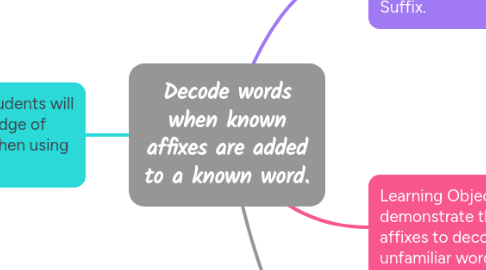Decode words when known affixes are added to a known word.
作者:Kennedy Calvin


1. Learning Objective #1: Students will demonstrate their knowledge of affixes by defining them then using them to craft a word.
1.1. Activity: Worksheet that has a list of affixes. Students will need to define the meaning of each affix then find a word that has the affix in it. For example, a student would define the affix "Un" and then write a word like "Unreliable".
1.1.1. Assessment: Students will be able to successfully complete the worksheet by providing the correct definition to each affix and then listing an existing word that contains that affix as an example.
2. Learning Objective #2: Students will collaborate and engage in a class game that teaches them the difference between a Prefix and a Suffix.
2.1. Activity: Students will play a game of "Pin the Prefix/ Suffix on the Word". There will be a notecard with a base word on the wall and students will be given smaller notecards with either a prefix or a suffix. Students will then take turns to determine if their affix is a prefix or suffix by pinning it either in front of the base word or after it.
2.1.1. Assessment: Students will demonstrate their knowledge of the difference between prefixes and suffixes by successfully determining whether their given affix is a suffix or a prefix.
3. Learning Objective #3: Students will demonstrate their ability to use affixes to decode the meaning of unfamiliar words.
3.1. Activity: Students will roleplay as detectives and try to uncover the meaning of three unknown words by using the definitions of its affixes. For example, a student who doesn't know what a submarine is, would identify that "sub" means below and "Marine" means water so submarine would have something to do with being underwater.
3.1.1. Assessment: Students will use critical thinking skills to piece together the meaning of a word by looking only at its affixes.
